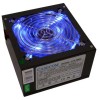|
Computer power supplies are
something I will generally have
a go at repairing, I'm not
always successful though. Here
in this section I share my
efforts, this might be helpful
to others, or perhaps you can
point me in the right direction
when my own attempt has failed -
I'm no expert.
| Power supplies deal with high voltages and
should not be meddled with, even when unplugged the
components can still hold a dangerous charge. I've witnessed
a bulk-capacitor experience a rapid discharge when it
got shorted out on a stray item on my workbench - they pack
a punch that could be fatal. I typically leave a PSU
unplugged for a few days before venturing inside. |
|
IMAGE |
MAKE / MODEL |
DATE FIRST TACKLED |
REVISITED |
CONCLUSION |
READ MORE |
 |
Antec SU-430
|
2024 |
|
No |
[CLICK] |
 |
Enermax EMD625AWT Pro82 II 625w
|
2022 |
|
Partial |
[CLICK] |
 |
Casecom 500W
|
2021 |
- |
No |
[CLICK] |
| |
Laptop Power Supplies
|
|
|
- |
[CLICK] |
 |
The
Blue 600W - SN-600AS
|
2021 |
- |
Success |
[CLICK] |
Some rules of thumb:
- Keep your power supply free from
dust; this can restrict airflow, cause components to overheat,
or, if that dust gets damp, can cause a short.
- Don't ignore a noisy fan; treat
a noisy fan as an early-warning sign and replace or service it -
the next indication could be that it stops spinning and then
things overheat.
- Visually inspect a power supply
to see if capacitors appear to be failing; replacing these in
time could prevent further failure.
- Understand your rails; for
example, some PSUs spread load across multiple 12V rails while
others place all on one rail - I believe the latter is better
since you don't risk overloading a particular rail, such as with
a demanding graphics card.
[Back
to Top]
|